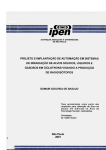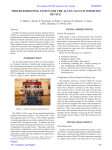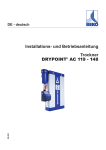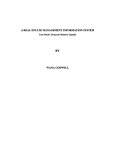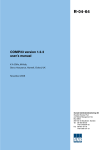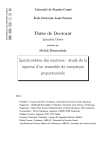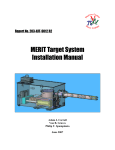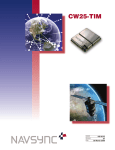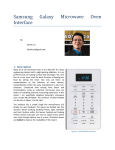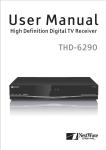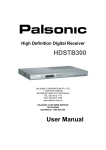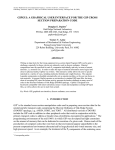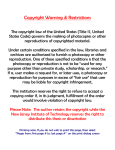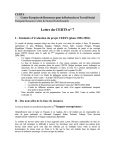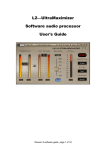Download WE6RFP027
Transcript
Proceedings of PAC09, Vancouver, BC, Canada WE6RFP027 PERFORMANCE OF AND UPGRADES TO THE SNS COLLIMATOR SYSTEMS* M.A. Plum, A.A. Abdou, L. Jacobs, J. Janney, P.J. Geoghegan, S. McTeer, I. Popova, P. Ferguson, A. Zhukov, Oak Ridge National Laboratory, Oak Ridge, TN, USA Abstract As the Spallation Neutron Source (SNS) beam power is increased, the collimator systems are becoming correspondingly more important. The High Energy Beam Transport (HEBT) transverse collimators are now routinely used during neutron production. We are in the process of redesigning the HEBT momentum collimation system due to problems with gas production from radiolysis. The Ring collimators are designed for twostage operation but to date they are mainly used in onestage mode. In this paper we will discuss the status, the operational performance, and upgrades to the collimation systems. INTRODUCTION With a design proton beam power of 1.4 MW delivered to the neutron spallation target, even beam losses that amount to of a small fraction of a percent become significant and cause high activation levels that can impede accelerator maintenance activities. The SNS collimator systems [1] are designed to alleviate this problem by cleaning beam halo and tails that can cause beam loss, by stripping it off and depositing it into wellshielded enclosures. The SNS has collimator systems in the HEBT, the Ring, and the Ring-to-Target (RTBT) beam lines. In the straight-ahead portion of the HEBT, shortly after the linac, two collimator systems, each rated for up to 2 kW of beam power, scrape beam tails that may be present in the transverse phase space. Each system employs four (top, bottom, left and right), independently controlled, thin (~25 mg/cm2) carbon scrapers to strip the tails of the H− beam to H+. Once the beam polarity of the tails is changed they take a different path through the magnetic lattice and are absorbed in heavily-shielded water-cooled cylindrically-symmetric collimators. Further along the HEBT beam line, at a point of high dispersion in the 90 deg. arc, a third set of left-right scrapers intercept the high and low momentum tails of the beam. In this case the newly created H+ particles are bent by the arc dipoles in the direction opposite to the main H− beam, into a short beam line leading to a water-cooled beam stop capable of absorbing up to 2.5 kW of beam power. In the Ring, where the beam species is H+, simple charge-exchange stripping is no longer an option, so instead the beam tails are intercepted by thick watercooled tungsten scrapers. The intercepted beam is ___________________________________________ * ORNL/SNS is managed by UT-Battelle, LLC, for the U.S. Department of Energy under contract DE-AC05-00OR22725 scattered and collected in three water-cooled heavilyshielded cylindrically-symmetric collimators much like the first two HEBT units, each rated for 2 kW of beam power. Finally, in the RTBT, two more collimator systems, again much like the HEBT units but in this instance without any scrapers, are used to protect the neutron spallation target by intercepting any beam particles that may have distorted trajectories due to extraction kicker misfires. EARLY OPERATING EXPERIENCE During the initial months of low-beam-power operations the collimator systems were seldom pressed into service, since they showed negligible improvement in beam loss. However, as the beam power was increased to greater than about 300 kW, the HEBT collimator systems began to yield significant improvements in downstream beam loss, especially in the injection dump beam line, where we are most sensitive to beam halo and tails. The momentum collimator system gave the biggest improvements, but in April 2008 a pump in the water cooling system for this collimator failed due to a concurrent pressure and temperature excursion. A postmortem analysis of the event showed that the over pressurization was caused by a combination of excessive beam power and the inability to effectively vent the gases created by radiolysis. The pump was replaced, but after discovering the radiolysis gas venting issue the momentum dump was removed from service since radiolysis is a problem at any beam power. The momentum dump is now being re-designed (more on this later). After the momentum dump, the next-most-effective collimators are the upstream HEBT transverse phase space collimator systems. These systems are now in routine use. They mainly improve the beam losses in the injection dump beam line, sometimes by as much as a factor of 25. They sometimes also improve beam loss in the HEBT arc. However, there are also times when they yield very little beam loss improvement, depending on the quality of the beam from the linac. The ring collimator system is designed to operate as a two-stage system. First the beam tails are intercepted by the scrapers, then the scattered beam is intercepted by the collimators. However, the system can also be used as a single-stage system where the scrapers are retracted and the limiting aperture becomes the collimators themselves. This mode maximizes the dynamic aperture in the ring, and this is the mode that we typically use. On the occasions where the scrapers have been brought into play we did not observe a significant improvement in beam Accelerator Technology - Subsystems T19 - Collimation and Targetry 2847 WE6RFP027 Proceedings of PAC09, Vancouver, BC, Canada loss, so it is simpler for now to use this system in singlestage mode. As we further increase the beam power, we anticipate that we will begin using the scrapers. The purpose of the RTBT collimator systems is to protect the target from errant beams caused by extraction kicker misfires, and because there are no adjustable components, these collimators have been used as originally planned since the first day of beam to target, and with the possible exception of radiolysis issues, they are working well. RADIOLYSIS The general definition of radiolysis is the dissociation of molecules by ionizing radiation. In our case we have the dissociation of water molecules in the cooling water system by the ~1 GeV proton beam. All of our collimator systems absorb the beam power in a water-cooled bed of stainless-steel balls, and a typical path of a charged particle hitting the collimator will include some water. Radiolysis products include hydrogen, hydrogen peroxide, oxygen and oxygen-containing radicals. A gas sample taken in December 2008 from the HEBT transverse collimator cooling water system showed elevated levels of H2 (0.45% vs. the naturally occurring 0.0002% in air) and depressed levels of O2 (13.2% vs. 20.9% in air). The increased level of H2 is consistent with the radiolysis process. The depressed level of O2 can be attributed to the sampling method which introduced air, possible recombination of hydrogen and oxygen within the water loop, and the complicated water chemistry. Particle tracking simulations using MCNPX [2] have also been performed to estimate the fraction of the beam power that is deposited in the HEBT transverse collimator cooling water. The collimator geometry model was developed according to design drawings, except that the particle bed was represented by set of coincident cylinders of steel and water in a volume ratio of about 65%/35%. The beam source was represented by a disk source perpendicular to the beam center line, with circular symmetry on the plane of the disk, from radii 2.3 cm to 5.3 cm, and with the 1 GeV protons directed parallel to the beam line axis. The energy deposition was calculated on the basis of one incoming proton and then normalized to the full beam intensity. This model indicates that for 2 kW of beam power absorbed by a collimator system, ~160 watts is deposited in the water. Measurements taken in the neutron production target deionized water cooling systems indicate that ~ 0.4 to 0.5 molecules of hydrogen are produced per 100 eV of energy absorbed in the water. This, combined with the particle tracking simulations for the HEBT collimators, allows an estimate of the hydrogen gas creation to be ~0.5 – 0.7 l/h for 2 kW absorbed by a HEBT collimator system. This gas generation rate is comparable to that estimated for the momentum collimator system. However, gas can be more effectively vented from the HEBT transverse collimator cooling water system, and to date it has not caused any operational problems. DESIGN OF NEW MOMENTUM COLLIMATOR SYSTEM The new momentum collimator system will include an upgrade of the beam diagnostics between the carbon scrapers and the beam dump. The initial design had just beam loss monitors to estimate how much beam was being scraped and delivered to the dump. As shown in Fig. 1, the new design will include a beam current monitor to directly measure the beam power being delivered to the dump, a beam profile / position monitor to measure the beam density and position at the entrance to the dump, a dipole corrector to steer the beam to the center of the dump, and some additional beam loss monitors. The beam dump itself is also being redesigned. Our goal is to design and build a forced-air-cooled dump to completely eliminate the complications (e.g. radiolysis, resin beds, etc) that come with water cooled systems. The conceptual design calls for removing the water-cooled portion of the dump (thus leaving a 38 x 38 x 331 cm3 hole in the existing large stack of steel and concrete shielding) and replacing it with an AJT graphite and AISI A36 steel assembly. The steel is necessary since the space available is not sufficient to fully stop a 1.3 GeV proton beam by using only graphite. Two isometric CAD images of the new design are shown in Figs. 2-3. The new dump will be designed for 5 kW – twice the rating of the old dump. Recirculated air is pumped into the outer jacket of the new assembly. The reentrant vacuum window is also cooled by this air. A heat exchanger, located in the tunnel and cooled by the magnet water cooling loop, will remove the heat from the dump. Prof ile BCM BLM BLM BLM Dipole corrector Figure 1: Momentum dump beam line upgrade. The new dipole corrector and beam diagnostics are shown in red. SCRAPER ELECTRONICS The original design of the three HEBT collimator systems had just beam loss monitors to estimate how much beam was intercepted by the scrapers and sent to the collimators/dump. This is an indirect and inaccurate Accelerator Technology - Subsystems 2848 T19 - Collimation and Targetry Proceedings of PAC09, Vancouver, BC, Canada measurement, and it does not allow one to determine how much beam is individually intercepted by the scrapers. WE6RFP027 emitted from other scrapers (in case of several scrapers being inserted simultaneously). An example set of waveforms is shown in Fig. 4. Based on measurements such as this one, the beam power typically intercepted during neutron production operations ranges from zero to a few hundred Watts, well within the design capacity of 2 kW for each collimator system. The bandwidth of the system is 10 kHz. The electronics are calibrated by comparing upstream and downstream beam current monitor signals with the scraper signals, under carefully controlled conditions. Figure 2: The new momentum dump including the square housing that slips inside of the shielding. Recirculated air is pumped into the outer port and returns on the inner port. Figure 4: Example waveforms from the HEBT scraper electronics. Two of the four scrapers are inserted far enough to intercept some beam. FUTURE PLANS Figure 3: Cross section of the new momentum dump. Green shows the reentrant vacuum window, brown shows the graphite, and magenta shows the steel. These scrapers have now been modified to be electrically isolated, and the signals caused by secondary electron emission are collected by electronics interfaced to the control system and the machine protection system. The waveforms can be observed in the control room, and the user can determine how much beam power is intercepted by each scraper. Also, if the signal level exceeds a pre-determined threshold (indicating that too much beam power is being intercepted), the machine protection system will turn off the beam. This function is performed in an analog front end that is independent of software and timing. To mitigate noise issues twisted-pair type cable is used to carry the reference noise line along with signal line. The reference signal is amplified separately and subtracted from the scraper signal. The electronics also allows the application up to 250 V of negative HV bias to the scraper plate, thus increasing the secondary electron emission and rejecting any electrons We plan to install the new momentum dump in 2010. Based on the short time we were able to make use of the original dump, we expect to see immediate improvements in the downstream beam loss, especially in the injection dump beam line area. The ring scrapers have so far been rarely used during the typical neutron production runs because they have not significantly improved the overall beam loss in the ring. However, as we continue to increase the beam power, we will monitor the performance of this system to determine how best to use it to control the beam loss. We expect that it greatest value will be at the highest beam intensities. REFERENCES [1] N. Catalan-Lasheras and D. Raparia, PAC’01, p. 3263 (2001). N. Catalan-Lasheras et al., PRSTAB vol. 4 010101 (2001). [2] L.S. Waters, ed., “MCNPX User’s Manual – Version 2.1.5”, Los Alamos National Laboratory, NM, TPOE83-G-UG-X-00001, Nov. 1999. Accelerator Technology - Subsystems T19 - Collimation and Targetry 2849




